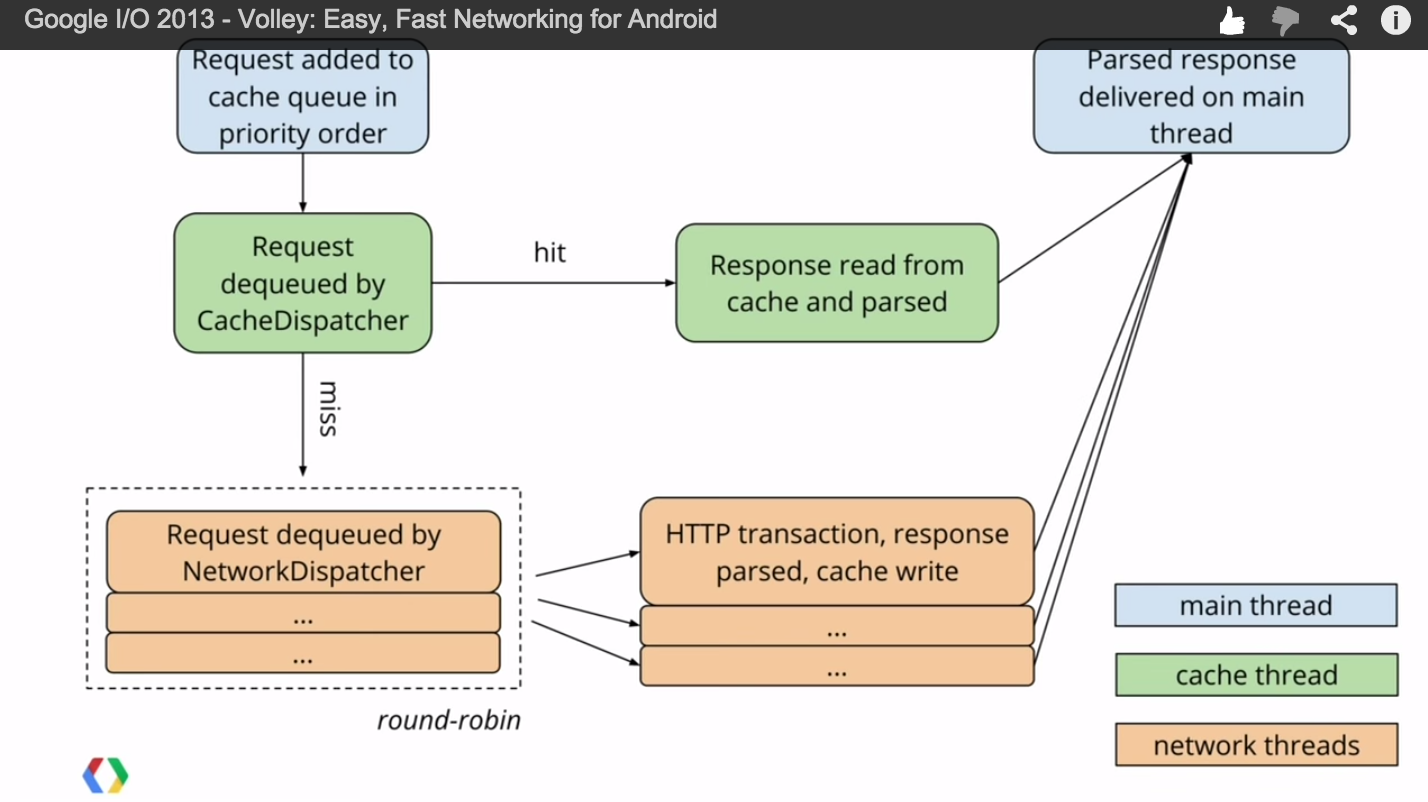Android库Volley的使用介绍
Android Volley 是Google开发的一个网络lib,可以让你更加简单并且快速的访问网络数据。Volley库的网络请求都是异步的,你不必担心异步处理问题。
Volley的优点:
- 请求队列和请求优先级
- 请求Cache和内存管理
- 扩展性性强
- 可以取消请求
下载和编译volley.jar
- 需要安装git,ant,android sdk
clone代码:git clone https://android.googlesource.com/platform/frameworks/volley
- 编译jar:
android update project -p . ant jar
添加volley.jar到你的项目中
不过已经有人将volley的代码放到github上了:
https://github.com/mcxiaoke/android-volley,你可以使用更加简单的方式来使用volley:
Maven
format: jar
<dependency>
<groupId>com.mcxiaoke.volley</groupId>
<artifactId>library</artifactId>
<version>1.0.6</version>
</dependency>
Gradle
format: jar
compile 'com.mcxiaoke.volley:library:1.0.6'
Volley工作原理图

创建Volley 单例
使用volley时,必须要创建一个请求队列RequestQueue,使用请求队列的最佳方式就是将它做成一个单例,整个app使用这么一个请求队列。
public class AppController extends Application {
public static final String TAG = AppController.class
.getSimpleName();
private RequestQueue mRequestQueue;
private ImageLoader mImageLoader;
private static AppController mInstance;
@Override
public void onCreate() {
super.onCreate();
mInstance = this;
}
public static synchronized AppController getInstance() {
return mInstance;
}
public RequestQueue getRequestQueue() {
if (mRequestQueue == null) {
mRequestQueue = Volley.newRequestQueue(getApplicationContext());
}
return mRequestQueue;
}
public ImageLoader getImageLoader() {
getRequestQueue();
if (mImageLoader == null) {
mImageLoader = new ImageLoader(this.mRequestQueue,
new LruBitmapCache());
}
return this.mImageLoader;
}
public <T> void addToRequestQueue(Request<T> req, String tag) {
// set the default tag if tag is empty
req.setTag(TextUtils.isEmpty(tag) ? TAG : tag);
getRequestQueue().add(req);
}
public <T> void addToRequestQueue(Request<T> req) {
req.setTag(TAG);
getRequestQueue().add(req);
}
public void cancelPendingRequests(Object tag) {
if (mRequestQueue != null) {
mRequestQueue.cancelAll(tag);
}
}
}
另外,你还需要一个Cache来存放请求的图片:
public class LruBitmapCache extends LruCache<String, Bitmap> implement ImageCache {
public static int getDefaultLruCacheSize() {
final int maxMemory = (int) (Runtime.getRuntime().maxMemory() / 1024);
final int cacheSize = maxMemory / 8;
return cacheSize;
}
public LruBitmapCache() {
this(getDefaultLruCacheSize());
}
public LruBitmapCache(int sizeInKiloBytes) {
super(sizeInKiloBytes);
}
@Override
protected int sizeOf(String key, Bitmap value) {
return value.getRowBytes() * value.getHeight() / 1024;
}
@Override
public Bitmap getBitmap(String url) {
return get(url);
}
@Override
public void putBitmap(String url, Bitmap bitmap) {
put(url, bitmap);
}
}
别忘记在AndroidManifest.xml文件中添加android.permission.INTERNET权限。
创建Json请求
volley自带了JsonObjectRequest和JsonArrayRequest分别来处理Json对象请求和Json数据请求(但是voley没有使用gson库写一个GsonRequest,发送一个request,volley直接返回一个java对象,不过我们可以自己写)。
创建json object请求
发送一个请求只要这么简单,创建一个JsonRequest对象,写好response回调接口,并把这个请求放到请求队列中就可以了。JsonArrayRequest也类似。
// Tag used to cancel the request
String tag_json_obj = "json_obj_req";
String url = "http://api.androidhive.info/volley/person_object.json";
JsonObjectRequest jsonObjReq = new JsonObjectRequest(Method.GET,url, null,
new Response.Listener<JSONObject>() {
@Override
public void onResponse(JSONObject response) {
Log.d(TAG, response.toString());
}
}, new Response.ErrorListener() {
@Override
public void onErrorResponse(VolleyError error) {
VolleyLog.d(TAG, "Error: " + error.getMessage());
}
});
// Adding request to request queue
AppController.getInstance().addToRequestQueue(jsonObjReq, tag_json_obj);
创建String请求
StringRequest可以用来请求任何string类型的数据:json,xml,文本等等。
// Tag used to cancel the request
String tag_string_req = "string_req";
String url = "http://api.androidhive.info/volley/string_response.html";
ProgressDialog pDialog = new ProgressDialog(this);
pDialog.setMessage("Loading...");
pDialog.show();
StringRequest strReq = new StringRequest(Method.GET,
url, new Response.Listener<String>() {
@Override
public void onResponse(String response) {
Log.d(TAG, response.toString());
pDialog.hide();
}
}, new Response.ErrorListener() {
@Override
public void onErrorResponse(VolleyError error) {
VolleyLog.d(TAG, "Error: " + error.getMessage());
pDialog.hide();
}
});
// Adding request to request queue
AppController.getInstance().addToRequestQueue(strReq, tag_string_req);
创建POST请求
上面说的都是GET请求,下面来说一下POST请求,与GET请求不同的是,只要在创建请求的时候将请求类型改为POST请求,并且override Request的getParams方法即可。
// Tag used to cancel the request
String tag_json_obj = "json_obj_req";
String url = "http://api.androidhive.info/volley/person_object.json";
ProgressDialog pDialog = new ProgressDialog(this);
pDialog.setMessage("Loading...");
pDialog.show();
JsonObjectRequest jsonObjReq = new JsonObjectRequest(Method.POST,
url, null,
new Response.Listener<JSONObject>() {
@Override
public void onResponse(JSONObject response) {
Log.d(TAG, response.toString());
pDialog.hide();
}
}, new Response.ErrorListener() {
@Override
public void onErrorResponse(VolleyError error) {
VolleyLog.d(TAG, "Error: " + error.getMessage());
pDialog.hide();
}
}) {
@Override
protected Map<String, String> getParams() {
Map<String, String> params = new HashMap<String, String>();
params.put("name", "Androidhive");
params.put("email", "abc@androidhive.info");
params.put("password", "password123");
return params;
}
};
// Adding request to request queue
AppController.getInstance().addToRequestQueue(jsonObjReq, tag_json_obj);
添加请求头部信息
// Tag used to cancel the request
String tag_json_obj = "json_obj_req";
String url = "http://api.androidhive.info/volley/person_object.json";
ProgressDialog pDialog = new ProgressDialog(this);
pDialog.setMessage("Loading...");
pDialog.show();
JsonObjectRequest jsonObjReq = new JsonObjectRequest(Method.POST,url, null,new Response.Listener<JSONObject>() {
@Override
public void onResponse(JSONObject response) {
Log.d(TAG, response.toString());
pDialog.hide();
}
}, new Response.ErrorListener() {
@Override
public void onErrorResponse(VolleyError error) {
VolleyLog.d(TAG, "Error: " + error.getMessage());
pDialog.hide();
}
}) {
/**
* Passing some request headers
* */
@Override
public Map<String, String> getHeaders() throws AuthFailureError {
HashMap<String, String> headers = new HashMap<String, String>();
headers.put("Content-Type", "application/json");
headers.put("apiKey", "xxxxxxxxxxxxxxx");
return headers;
}
};
// Adding request to request queue
AppController.getInstance().addToRequestQueue(jsonObjReq, tag_json_obj);
创建Image请求
Volley库中自带了NetworkImageView类,这个ImageView可以自动使用volley下载图片
用NetworkImageView加载图片
首先,说明一下,加载图片的原理:
NetworkImageView加载图片需要一个ImageLoader和一个图片URL,这个ImageLoader对象需要一个请求队列对象和ImageCahe对象。调用NetworkImageView的setUrl方法后,首先会判断当前ImageView的URL和新传入的URL是否一致,如果相同,就不用再发送http请求了,如果不同,那么就使用ImageLoader对象来发送http请求获取图片。
ImageLoader imageLoader = AppController.getInstance().getImageLoader();
// If you are using NetworkImageView
imgNetWorkView.setImageUrl(Const.URL_IMAGE, imageLoader);
加载一个图片只要这么简单~~~
用ImageView来加载图片
这个过程和NetworkImageView类似
ImageLoader imageLoader = AppController.getInstance().getImageLoader();
// If you are using normal ImageView
imageLoader.get(Const.URL_IMAGE, new ImageListener() {
@Override
public void onErrorResponse(VolleyError error) {
Log.e(TAG, "Image Load Error: " + error.getMessage());
}
@Override
public void onResponse(ImageContainer response, boolean arg1) {
if (response.getBitmap() != null) {
// load image into imageview
imageView.setImageBitmap(response.getBitmap());
}
}
});
可以再简单一点:
// Loading image with placeholder and error image
imageLoader.get(Const.URL_IMAGE, ImageLoader.getImageListener(imageView, R.drawable.ico_loading, R.drawable.ico_error));
ImageLoader.getImageListener方法中已经写了一个默认的ImageListener了
Volley Cache
volley中自带了强大的cache机制来管理请求cache,这会减少网络请求次数和用户等待时间。
从请求Cache中加载请求
Cache cache = AppController.getInstance().getRequestQueue().getCache();
Entry entry = cache.get(url);
if(entry != null){
try {
String data = new String(entry.data, "UTF-8");
// handle data, like converting it to xml, json, bitmap etc.,
} catch (UnsupportedEncodingException e) {
e.printStackTrace();
}
}
}else{
// Cached response doesn't exists. Make network call here
}
使请求缓存失效
失效并不意味这删除,Volley还会继续使用缓存的对象直到从服务器上获取到了新的数据,新的数据会覆盖旧的数据。
AppController.getInstance().getRequestQueue().getCache().invalidate(url, true);
关闭Cache
如果你想将某一个请求的Cache功能关闭,直接调用Request的setShouldCache()方法就可以:
// String request
StringRequest stringReq = new StringRequest(....);
// disable cache
stringReq.setShouldCache(false);
将某一URL的Cache删除
调用Cache的remove方法可以删除这个URL的cache:
AppController.getInstance().getRequestQueue().getCache().remove(url);
删除所有的Cache
AppController.getInstance().getRequestQueue().getCache().clear();
取消请求
在你添加一个请求到请求队列中的时候,你可以发现,addToRequestQueue(request, tag)方法还接受一个tag参数,这个tag就是用来标记某一类请求的,这样就可以取消这个tag的所有请求了:
String tag_json_arry = "json_req";
ApplicationController.getInstance().getRequestQueue().cancelAll("feed_request");
请求优先级
在创建一个request的时候可以Override Request方法的getPriority方法返回一个优先级,优先级分为:Normal, Low, Immediate, High
private Priority priority = Priority.HIGH;
StringRequest strReq = new StringRequest(Method.GET,
Const.URL_STRING_REQ, new Response.Listener<String>() {
@Override
public void onResponse(String response) {
Log.d(TAG, response.toString());
msgResponse.setText(response.toString());
hideProgressDialog();
}
}, new Response.ErrorListener() {
@Override
public void onErrorResponse(VolleyError error) {
VolleyLog.d(TAG, "Error: " + error.getMessage());
hideProgressDialog();
}
}) {
@Override
public Priority getPriority() {
return priority;
}
};
Missing! 创建xml请求
就像创建Gson请求一样,你可以自定义一个XMLRequest类来请求xml数据